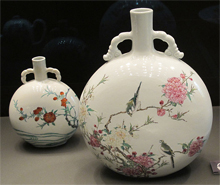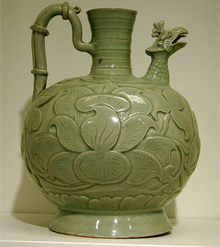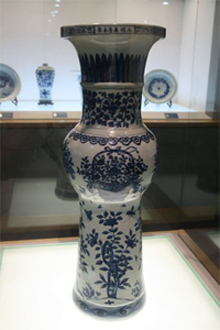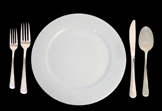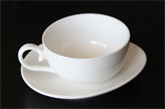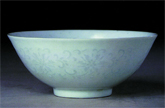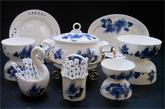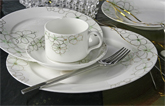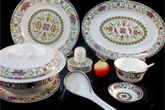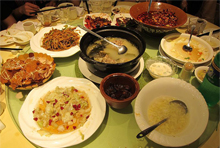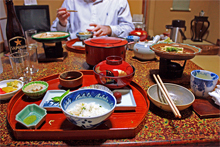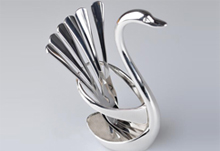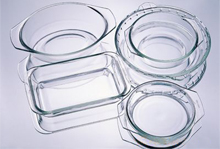| Tableware is the dishes or dishware used for setting a table, serving food and for dining. Tableware can be meant to include cutlery and glassware. The nature, variety, and number of objects varies from culture to culture, religions, and cuisines. Histroy of the tableware
|
Dinnerware
| | | | |
| | | | |
| Dishes are usually made of ceramic materials such as earthenware, stoneware, bone china or porcelain, however can be made of other materials such as wood, pewter, silver, gold, glass, acrylic and plastic. Dishes are purchased either by the piece or by set which include either four, eight, or twelve place settings. Individual pieces, such as those needed as replacement pieces for broken dishes, can be purchased from "open stock" inventory at shops, or from antique dealers if the pattern is no longer in production. Dish sizes Dishes come in standard sizes, which are set according to the manufacturer. They are similar throughout the industry. In descending order by diameter size, standard plate sizes are: charger, 12 inches dinner plate, 10.5 inches dessert plate, 8.5 inches salad plate, 7.5 inches side plate, tea plate, 6.75 inches | |||
Table setting
| | | |
| Chinese tableware | Japanese tableware | Ethiopian tableware |
| Chinese tableware Chinese table settings are traditional in style. Table setting practices in Japan and other parts of East Asia have been influenced by Chinese table setting customs. The emphasis in Chinese table settings is on displaying each individual food in a pleasing way, usually in separate bowls or dishes. Japanese tableware Japanese ceramic tableware is an industry that is many centuries old. Unlike in Western cultures, where tableware is often produced and bought in matching sets, Japanese tableware is set on the table so that each dish complements the type of food served in it. Ethiopian tableware Ethiopian dining includes several rituals, including the washing of hands before a formal meal, while seated at the table, and the drinking of coffee at the table when the meal has ended. During the meal itself, guests are served injera, a piece of Ethiopian flatbread made of the grain teff. View more… | ||
Different types of the tableware
| Ceramic tableware | metal tableware | Glassware |
In the United States, tableware is most commonly referred to as dinnerware. Dinnerware can be meant to include glassware, however not flatware. In Britain, the term crockery is sometimes used for ceramic dishes. In the USA, ceramic dinnerware can be referred to as china. Sets of dishes are often referred to as a table service or service set. Table settings or place settings are the dishes, flatware (cutlery), and glassware used by an individual for formal and informal dining. In the United Kingdom, silver service or butler service are names of methods for serving a meal.

